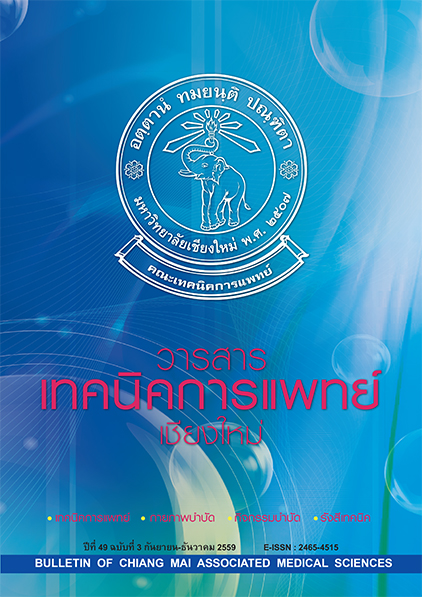A comparison of radiochemical purity testing of 99m Tc-Pentetate (DTPA) between paper and thin layer chromatographic techniques
Main Article Content
Abstract
Introduction: 99mTc-Pentetate or 99mTc-DTPA (99mTc-diethylenetriaminepentaacetic acid) is radiopharmaceutical material for renal function study in nuclear medicine. To ensure the quality of image, radiochemical purity of radiopharmaceutical material has to be tested before administration to patient. Thin layer chromatographic technique is widely used in radiochemical purity testing. Recently, paper chromatography is also recommended because it is cheaper than thin layer chromatography.
Objectives: To compare paper chromatographic and thin layer chromatographic techniques on the radiochemical purity testing of 99mTc-DTPA.
Materials and methods: The labeling time for preparing of 99mTc-DTPA were 5, 10 and 30 minutes. Radiochemical purity of 99mTc-DTPA was determined by using two chromatographic techniques. For paper chromatographic technique, a Whatman No.1 paper strip was used as stationary phase, normal saline and acetone as mobile phases. For thin layer chromatographic technique, a thin layer chromatography silica gel (TLC-SG) strip was used as a stationary phase, normal saline and acetone as a mobile phases.
Results: Percentage of radiochemical purity by paper chromatographic technique was 75.8±8.3, 88.3±3.7 and 92.0±3.4 at 5, 10 and 30 minutes of labeling times, respectively. Percentage of radiochemical purity by using thin layer chromatographic technique was 71.1±7.6, 91.2±0.9 and 90.5±0.3 at 5, 10 and 30 minutes of labeling times, respectively. From the study, it was found that percentage of radiochemical purity by using two techniques was not statistically significant difference (p>0.05).
Conclusion: A paper chromatographic and thin layer chromatographic technique was similarly in the radiochemical purity testing of 99mTc-DTPA.
Bull Chiang Mai Assoc Med Sci 2016; 49(2): 307-311. Doi: 10.14456/jams.2016.38
Article Details
Personal views expressed by the contributors in their articles are not necessarily those of the Journal of Associated Medical Sciences, Faculty of Associated Medical Sciences, Chiang Mai University.
References
2. IAEA. Technical Reports SeriEs No. 466 Technetium-99m radiopharmaceuticals : manufacture of kits Vienna: International Atomic Energy Agency; 2008. p75-6.
3. Norenberg JP, Vaidya MP, Hladik WB, 3rd, Pathak DR, Born JL, Anderson TL, et al. The effect of selected preparation variables on the radiochemical purity of 99mTc-sestamibi. Journal of nuclear medicine technology. 2005; 33(1): 34-41.
4. Hammermaier A, Reich E, Bogl W. Radiochemical purity and in vitro stability of commercial hippurans. Journal of nuclear medicine : official publication, Society of Nuclear Medicine. 1986; 27(6): 850-4.
5. Pandos G, Penglis S, Tsopelas C. Validation of a column method for technetium-99m exametazime quality control. Journal of nuclear medicine technology. 1999; 27(4): 306-8.
6. Tsopelas C, Smyth D. Characterization and quality control analysis of 99mTc-bicisate. Journal of nuclear medicine technology. 2005; 33(2): 89-93.
7. Borre MC, Tesan FC, Leonardi NM, Zubillaga MB, Salgueiro MJ. Validation of an alternative radiochemical purity method for [99mTc]pentetate ([99mTc]DTPA). Applied radiation and isotopes : including data, instrumentation and methods for use in agriculture, industry and medicine. 2013; 82: 322-4.


